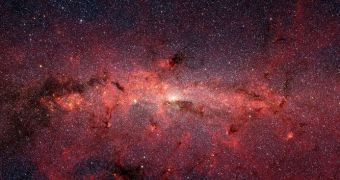A collaboration of astronomers announced the discovery of two protostars, located extremely close the the supermassive black hole at the core of the Milky Way. The objects were found just outside the dark behemoth's sphere of influence.
The thing that perplexes astronomers about this finding is that the objects shouldn't be there. The galactic core is no place for new stars, especially so close to a black hole about 4 million times heavier than our Sun.
The object is producing tremendously intense gravitational tides, which stir its surrounding, destroying molecules of the type stellar nurseries use to produce protostars. Without raw materials, it is unconceivable that new stars could form, and yet they were found at that location.
Astronomers with the research team say that the other alternative is the stars forming elsewhere, and then navigating towards the inner galactic core at high speeds. However, the probability of that occurring is extremely remote, the group says.
Experts from the Harvard-Smithsonian Center for Astrophysics (CfA) worked together with German colleagues at the Max Planck Institute for Radio Astronomy (MPIRA) for this study. The team used the Very Large Array (VLA) of radio telescopes for the observation sessions.
“We literally caught these stars in the act of forming,” CfA astronomer Elizabeth Humphreys told a meeting of the American Astronomical Society (AAS) today, in Long Beach, California.
Given the massive volumes of hydrogen gas and cosmic dust that enshroud the core of the Milky Way, visible-light observations cannot penetrate into the heart of the galaxy. As such, the team used infrared and radio wavelengths to conduct their research.
“We don’t understand the environment at the galactic center very well yet,” Humphreys said. “By combining observational studies like ours with theoretical work, we hope to get a better handle on what’s happening at our galaxy’s core,” the CfA expert says.
“Then, we can extrapolate to more distant galaxies,” she concludes. The end goal of such studies is to find out more about how stars form, and about the influences that black holes have at the cores of their host galaxies, Daily Galaxy reports.

 14 DAY TRIAL //
14 DAY TRIAL //